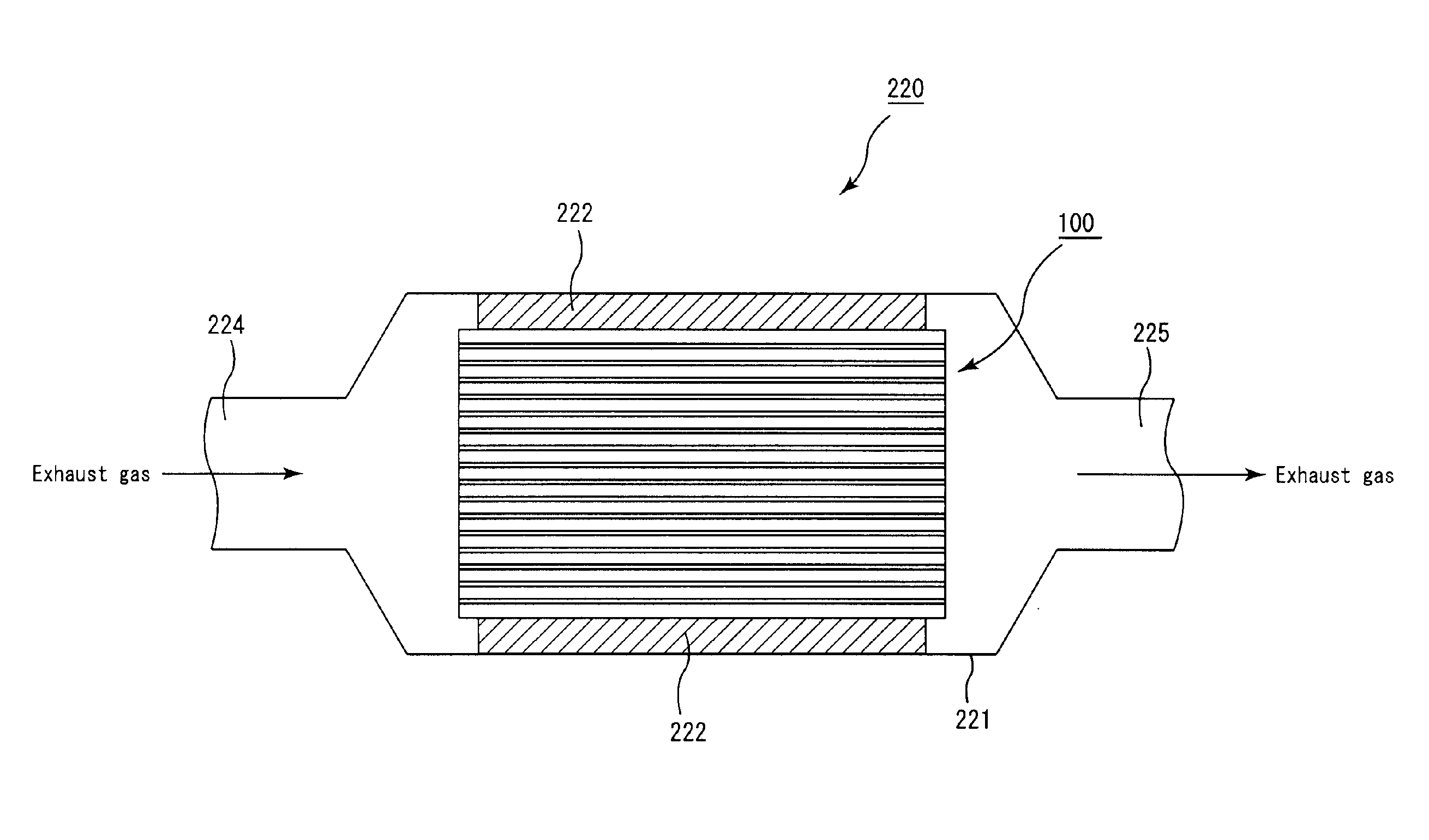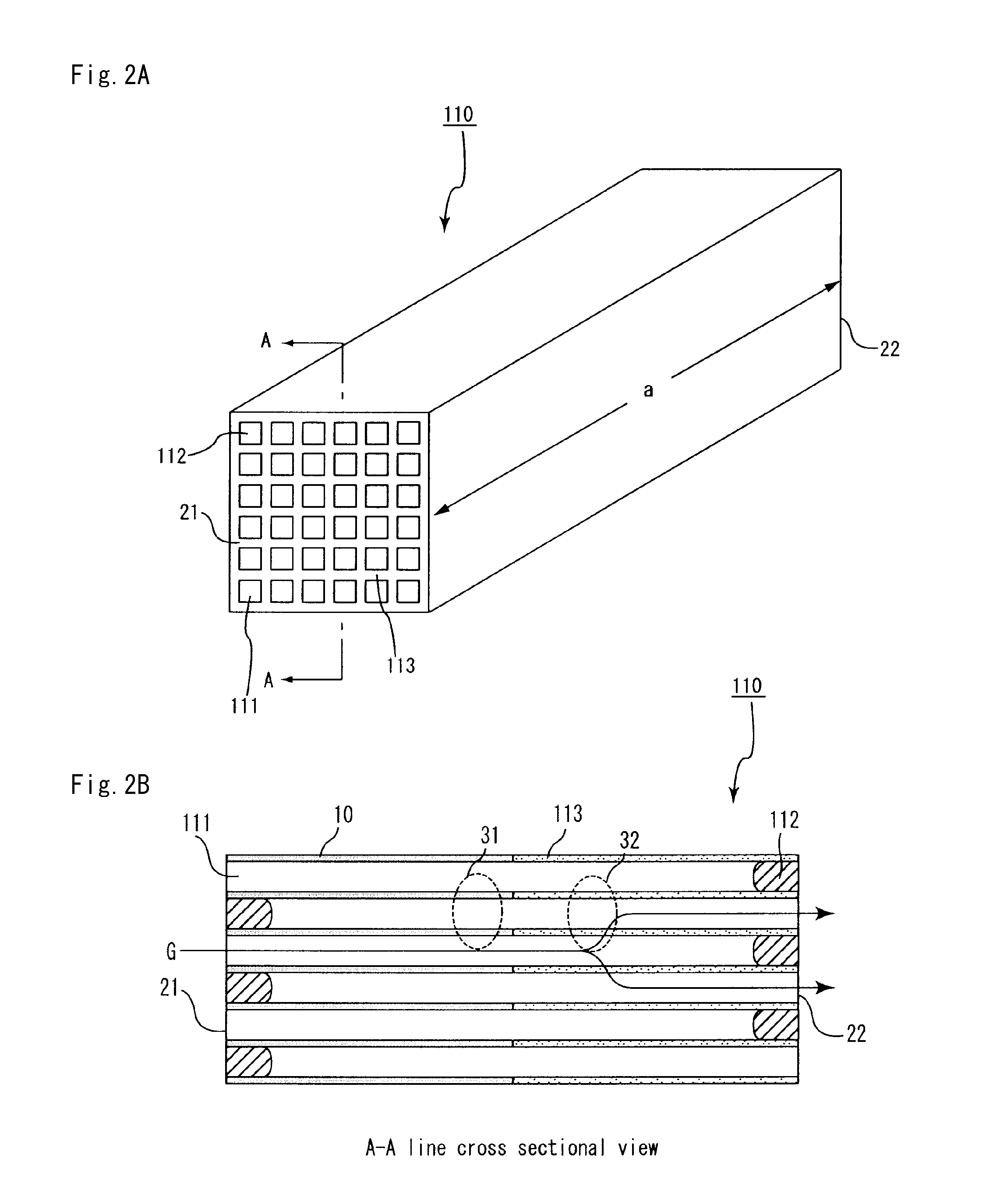Honeycomb filter and exhaust gas purifying apparatus
a technology of exhaust gas purification and honeycomb, which is applied in the direction of catalyst activation/preparation, machines/engines, metal/metal-oxide/metal-hydroxide catalysts, etc., can solve the problems of contamination of the environment and human body, construction machines raising serious problems,
- Summary
- Abstract
- Description
- Claims
- Application Information
AI Technical Summary
Problems solved by technology
Method used
Image
Examples
first embodiment
[0066]Referring to Figures, the following description will discuss a first embodiment which is one of the embodiments of the present invention.
[0067]FIG. 1 is a perspective view schematically showing an example of the honeycomb filter according to the embodiment of the present invention. FIG. 2A is a perspective view schematically showing one example of the honeycomb fired body forming the honeycomb filter according to the embodiment of the present invention, and FIG. 2B is a cross-sectional view taken along the line A-A in the FIG. 2A.
[0068]In a honeycomb filter 100, a plurality of honeycomb fired bodies as shown in FIG. 2A and FIG. 2B are combined with one another by interposing sealing material layers (adhesive layers) 101 in between to configure a ceramic block 103, and a sealing material layer (coat layer) 102 is formed on the outer periphery of the ceramic block 103.
[0069]The honeycomb fired body 110 includes porous silicon carbide as a main component, and is formed by a large...
example 1
Manufacturing of Honeycomb Fired Body
[0125]An amount of 52.8% by weight of coarse powder of silicon carbide having an average particle diameter of 22 μm and an amount of 22.6% by weight of fine powder of silicon carbide having an average particle diameter of 0.5 μm were wet-mixed, and to the resulting mixture were added and kneaded 2.1% by weight of acrylic resin, 4.6% by weight of an organic binder (methylcellulose), 2.8% by weight of a lubricant (UNILUB, made by NOF Corporation), 1.3% by weight of glycerin and 13.8% by weight of water to prepare a mixture, and the mixture was then extrusion-molded to manufacture a raw honeycomb molded body having virtually the same cross sectional shape as the cross sectional shape shown in FIG. 2A, with no cells being sealed.
[0126]Next, the raw honeycomb molded body was dried by using a microwave drying apparatus to obtain a dried body of the honeycomb molded body. Thereafter, a paste having the same composition as that of the raw molded body was...
examples 4 and 5
, Comparative Examples 2 and 3
[0170]By changing the average particle diameter of coarse powder of silicon carbide in the mixture composite, the composition of the raw material and the firing temperature as shown in Table 1, base members 1, 2, 4 and 5 having characteristics as shown in Table 2 were manufactured.
[0171]Each of these base members 1 to 5 had different mode diameters a ranging from 9 to 22 μm.
[0172]On these base members, a catalyst supporting layer was formed by using γ-alumina particles having an average particle diameter of 1.5 μm in the same manner as in Example 2 to manufacture a honeycomb filter as shown in Table 5.
[0173]The respective characteristics of each of these honeycomb filters were measured in the same manner as in Example 1, and the results of the measurements are shown in Table 6 together with the results of Example 2.
TABLE 5Catalyst supporting layer on inlet sideAluminaRange ofFormationAmount ofparticleBaseformationpositionformationdiametermember(%)(mm)(g...
PUM
| Property | Measurement | Unit |
|---|---|---|
| length | aaaaa | aaaaa |
| thermal conductivity | aaaaa | aaaaa |
| pore diameters | aaaaa | aaaaa |
Abstract
Description
Claims
Application Information
 Login to View More
Login to View More - R&D
- Intellectual Property
- Life Sciences
- Materials
- Tech Scout
- Unparalleled Data Quality
- Higher Quality Content
- 60% Fewer Hallucinations
Browse by: Latest US Patents, China's latest patents, Technical Efficacy Thesaurus, Application Domain, Technology Topic, Popular Technical Reports.
© 2025 PatSnap. All rights reserved.Legal|Privacy policy|Modern Slavery Act Transparency Statement|Sitemap|About US| Contact US: help@patsnap.com



